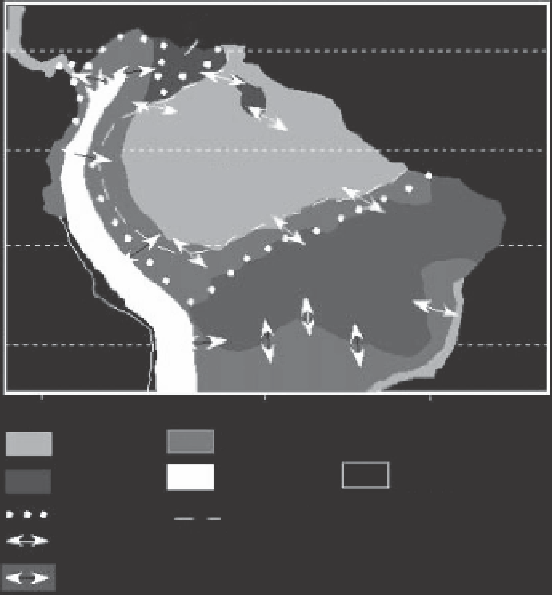Geoscience Reference
In-Depth Information
< 50 mm
10°N
Eq
> 100 mm
10°S
20°S
85°W
Rain forest
65°W
45°W
Zone of maximum probability of change
Desert
Mountains
Savanna
50 mm
100 mm
Change due mainly to moisture
Change due mainly to cooling
Figure 5.9
Areas within the Amazon basin most subject to change during Quaternary climate oscilla-
tions. Most change is predicted for areas that receive 50 mm-100 mm rainfall during the driest three
months of the year, making them priority areas for climate change-integrated conservation strategies
(Bush 2002). Reproduced with permission from John Wiley & Sons.
tolerance, and are therefore especially vulnerable to change (Bush et al. 2008). For example
the boundary between cloud forest and upland rainforest in the Andes, and rainforest, dry
forest, and savanna in the lowlands, are likely to be sensitive to increasing temperature (Mayle
et al. 2004). Ecotones in montane regions like the eastern flank of the Andes are especially
vulnerable to the effects of climate change and land-use, because of the interacting effects of
steep topography, which creates narrow bands of suitable climate space, and anthropogenic
land use. Using the location of cloud forest in the MHA as a guide, it is estimated that reduced
humidity and drought stress will affect forest communities, while elevation of the cloud base
and frost line by some 600 m in this century will shift plant communities upslope. Higher
elevations may become important refuges for lowland mesic taxa, but the higher altitudinal
biomes are running out of space (Malhi and Phillips 2004) (Bush 1996, 2002, Bush and Love-
joy 2007, Bush et al. 2008).
In addition, this upslope migration also means that cloud forest will move into an altitud-
inal band that is heavily dominated by anthropogenic activity, particularly fire and grazing,

Search WWH ::

Custom Search